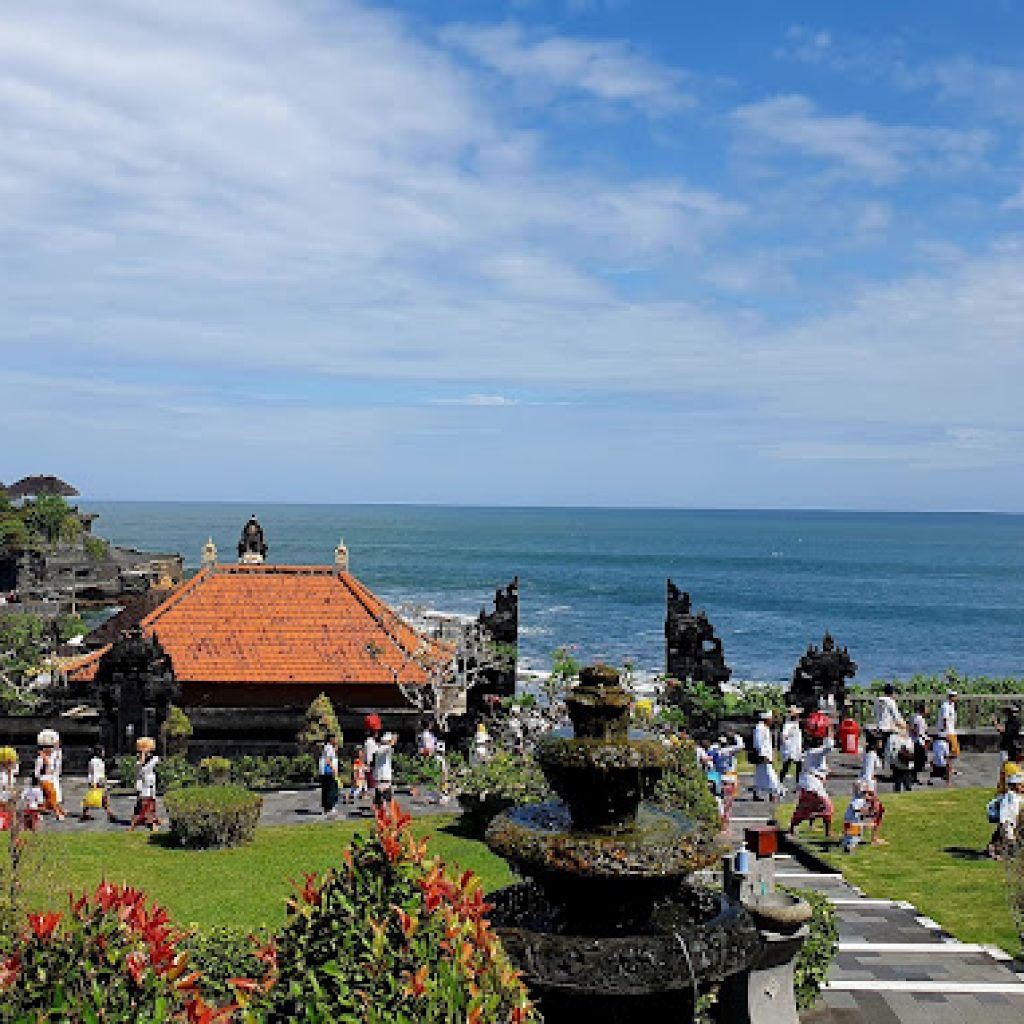Why is Tanah Lot such a standout among Bali’s temples, drawing admirers from everywhere?
Located in Tabanan, just 30 km from Denpasar, Tanah Lot is a key part of Bali’s rich cultural scene. It sits some 300 meters off the shore. Its name, “Land in the Sea,” shows how it sits uniquely in a beautiful, ocean setting. At sunset, this Balinese temple shines brightly, creating a scene that wows all who see it.
Built in the 16th century by a highly respected priest, Dang Hyang Nirartha, Tanah Lot has deep roots in history. It’s part of a three-temple system, each one honoring a different god. According to this system, the northern part is for Brahma, the central for Vishnu, and the southern area for Shiva.
But Tanah Lot is not just about its past and spiritual ties. It is a feat of architecture, shaped by Balinese myths. One of these myths includes a sea snake that guards the temple. Today, it’s one of Bali’s most famous temples, known for its scenic view of waves colliding and the magical sunsets.
Adding to its allure, Tanah Lot is ready to welcome tourists. It has good facilities like plenty of parking, clean bathrooms, and places to eat or shop. These efforts are in place to make every visit enjoyable and hassle-free.
Table of Contents
ToggleOur Bali Private Tour
Horizon Bali provide bali private tour that can bring you to look around bali island including tanah lot. Check our tour below or contact us for more information.
Tanah lot and ulundanu customizable trip
Did you know Ulun Danu Bratan Temple has been standing tall in Beratan Lake since 1556? It’s more than a place for worship. It honours several gods, such as Brahma, Vishnu, and Shiva. Known as part of the tanah lot and ulun danu private tour, it blends spiritual vibes with stunning natural scenery. The surrounding crater […]
Duration
1 day
Group Size
Unlimited
Uluwatu Temple And Sunset Trip
A Uluwatu sunset trip offers an unforgettable blend of natural beauty, cultural heritage, and breathtaking views. Whether you’re a nature enthusiast, a photography lover, or simply seeking tranquility amidst stunning surroundings, this bali private tours will leave an indelible mark on your Bali journey. This is the place that you will visit when you take […]
Duration
half day
Group Size
Unlimited
Location and Architecture of Tanah Lot Temple
Tanah Lot Temple, known as Pura Tanah Lot, sits in a beautiful offshore setting. It is about 20 kilometers (12 miles) from Denpasar. This iconic temple is built on a rocky islet, 300 meters from the shore. The ocean waves hitting the rocks make it a must-see.
Built in the 16th century by Dang Hyang Nirartha, the temple is significant. It honors Baruna, the sea god, and its view at sunset is famous in Bali. Its location in Beraban village, Kediri, makes it accessible and extra special.
More than looks, Tanah Lot shows impressive architectural skill. It’s on a rocky islet called Gili Beo, or “Bird Rock” in Balinese. This area includes the main temple and two others. These three temples honor the main Balinese gods, showing the deep meaning behind their structure.
There’s a story about a sea snake at the temple that protects it. According to locals, this mystical snake keeps away bad spirits and unwanted visitors. The temple has traditional Balinese architecture. Inside, it has beautiful carvings, old shrines, and open spaces for quiet reflection.
Tanah Lot’s recent renovation, supported by a big Japanese loan, is significant. It shows the temple’s cultural value is recognized around the world. This work ensures the site’s beauty and structure stay preserved for the future.
At Tanah Lot, visitors can join unique tours like the Balinese Cooking Class & Tanah Lot Temple Visit. This costs US$114 per person and offers a rich cultural experience. The temple opens at 06.00 am and closes at 07.00 pm. It’s best to visit from April to October for the best weather.
Rituals and Ceremonies at Tanah Lot Temple

Tanah Lot Temple is filled with spiritual rituals and ceremonies. Every 210 days, it celebrates Odalan. This event brings together the local community and draws visitors in search of spiritual blessings.
Odalan happens alongside Galungan and Kuningan festivals. Galungan celebrates the victory of good over evil. It’s when spirits of ancestors make a sacred visit.
Kuningan day follows, marking their return to heaven. This makes the festivals deeply meaningful. It brings the community closer and strengthens their spiritual ties.
During Odalan, you’ll see Balinese women in beautiful traditional clothes, carrying gifts. These gifts include flowers and fruits. They offer them in a special prayer at the temple, with the ocean in the background.
At Tanah Lot and nearby temples like Pura Batu Bolong, these traditions are kept alive. It shows how connected the communities are. They come together for these important ceremonies.
As the sunsets at Tanah Lot, you see its ancient beauty. This temple, built in the 16th century by Dang Hyang Nirartha, is a key place for Hindus in Bali. It has regular spiritual ceremonies like the Buddha Cemeng Langkir.
These events keep the spiritual life active at Tanah Lot. This area’s use of prayers, walks, and gatherings makes it important. It shows the deepness of Balinese spiritual beliefs.
Tourist Experience at Tanah Lot Temple

Visiting Tanah Lot Temple lets you dive into Bali’s rich culture. It’s about 30 km from Denpasar, close to Ngurah Rai Airport. This sacred place offers stunning panoramic views of the sea and beautiful gardens.
See the serene temple image at sunrise when everything is quiet. Later, the place buzzes with life as locals sell local handicrafts. These crafts are great souvenirs. Pull up a seat in the evening to watch the captivating sunsets. The sky lights up with colors, creating a magical scene.
There are more to see near the temple. For example, Pura Pekendungan holds the Ki Batu Gajah keris that’s said to keep plants healthy. Pura Batu Bolong and Pura Jero Kandang offer holy waters for wellness of animals and plants. Pura Enjung Galuh is for the Goddess Sri, wishing for welfare and prosperity. Also, Pura Batu Mejan provides a place for purification from bad vibes.
The area near Tanah Lot Temple has everything you need. From parking to clean toilets, and from art shops to hotels. You can visit the temple from 6 AM to 7 PM. But, people praying can access it any time.
Don’t forget the entrance fees. International adults pay IDR 75,000 (about USD 4). Kids pay IDR 40,000 (about USD 2.5). Locals pay less, to help keep the place beautiful.
Conservation Efforts and Future of Tanah Lot Temple
Tanah Lot Temple is a key place in Bali, loved by many. Yet, it fights to keep its special meaning while more tourists visit each year. Since the 16th century, the temple has kept its magic alive, thanks to the work of those who care for it. The money from entry fees is crucial. It helps in keeping the temple well-maintained, protecting its spiritual value against time and people.
Efforts to preserve Tanah Lot are not just about its structures. They also aim to keep its cultural events alive. These events are a big part of the temple’s life. They show visitors traditions and make the temple a place where nature and spirit meet. This idea helps manage the large number of people visiting, without losing the temple’s deep meaning for those who know it best.
Looking ahead, there are plans to keep Tanah Lot special and make it a better place to learn. This includes working with the local communities. These efforts mix sightseeing with caring for the environment. They help in keeping Bali’s nature and history safe from harm. The goal is for the temple to stay meaningful for many years, helping its surrounding communities as it does.
FAQ
What is the significance of Tanah Lot Temple?
Tanah Lot Temple is an iconic temple in Bali set on an offshore rock. It shows the mix of culture with nature. The temple is known for its beautiful sunset views.
Where is Tanah Lot Temple located?
Tanah Lot Temple is about 30 km from Denpasar. It’s located in the village of Beraban, in the Tabanan area. It’s 300 meters off the shore on Gili Beo, a rock island.
What inspired the architecture of Tanah Lot Temple?
The design of Tanah Lot Temple comes from Balinese stories. It was founded in the 16th century by Dang Hyang Nirartha. The temple is on a high rock near the ocean.
It’s made to honor Bhatara Segara, the Sea God. A sacred sea snake is said to protect it.
What rituals and ceremonies are held at Tanah Lot Temple?
Tanah Lot Temple has special ceremonies, like the Odalan festival. This happens every 210 days. It’s part of the Galungan and Kuningan celebrations.
During these times, Balinese women bring offerings in processions. This makes the temple even more spiritually important.
What facilities are available for tourists at Tanah Lot Temple?
There are many conveniences for visitors at Tanah Lot Temple. This includes parking, bathrooms, art stores, and eateries. People can also enjoy beautiful views and see other temples nearby.
They can witness Bali’s famous sunsets too.
How is Tanah Lot Temple being preserved?
Many steps are taken to keep Tanah Lot Temple in good shape. Money from entrance fees goes to its care. There’s an effort to keep tourism and the temple’s sacredness in balance.
The local community is also working to protect the environment. They’re promoting tourism that’s gentle on the area.





5 Comments